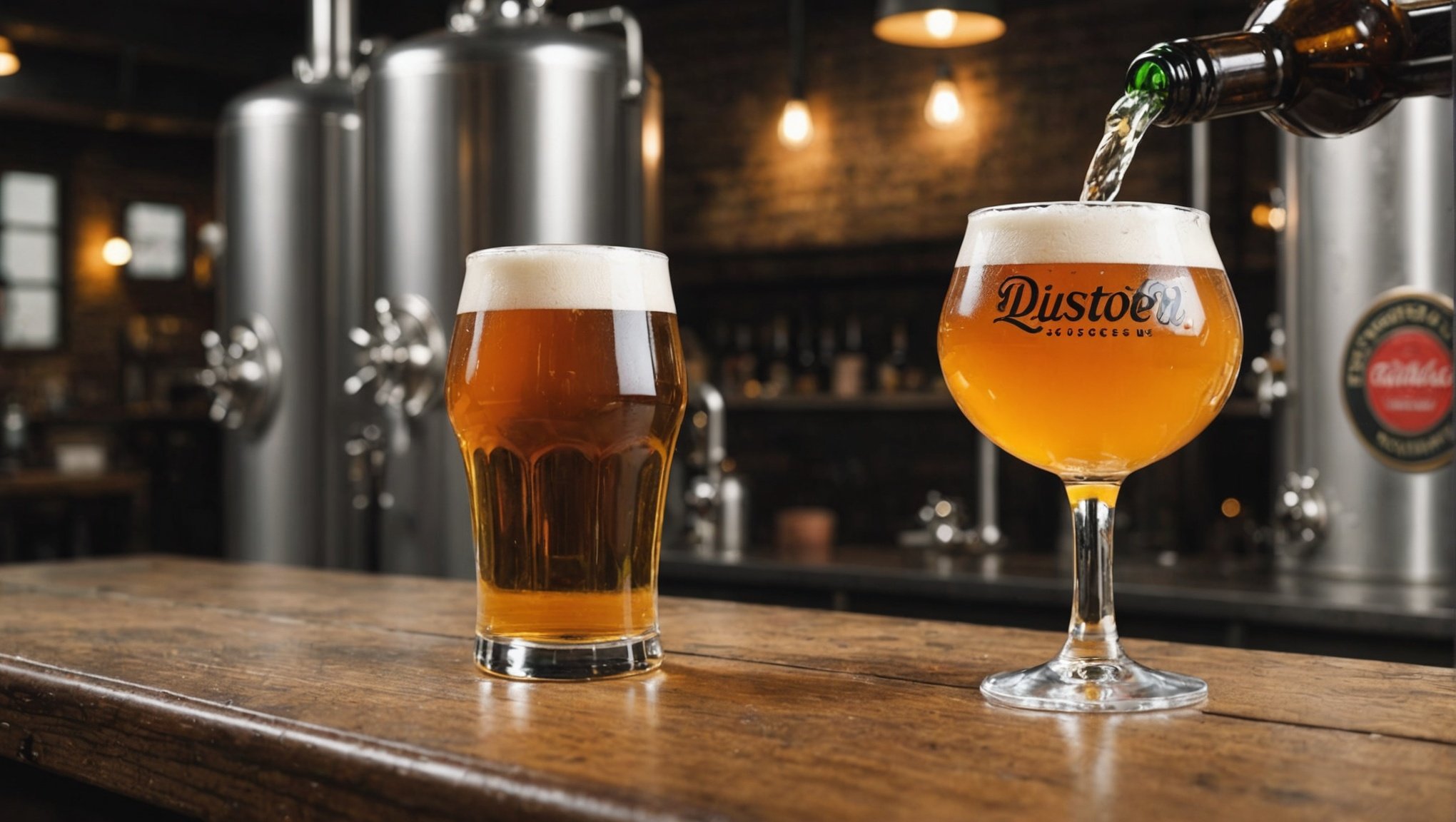Unlocking Success: Top Strategies for UK Breweries to Tap into the Non-Alcoholic Beer Market
The non-alcoholic beer market is experiencing a significant surge, driven by changing consumer preferences, health consciousness, and innovative brewing techniques. For UK breweries, tapping into this market can be a lucrative venture, but it requires a well-thought-out strategy. Here’s a comprehensive guide on how UK breweries can unlock success in the non-alcoholic beer market.
Understanding the Market Landscape
Before diving into specific strategies, it’s crucial to understand the current state of the non-alcoholic beer market. This segment has seen robust growth, with the global market size expected to grow from $20.08 billion in 2023 to $31.99 billion by 2028 at a CAGR of 9.9%.
Also read : Top Strategies for UK Businesses to Effectively Lead Remote Teams
Key Drivers of Growth
- Health Consciousness: Consumers are increasingly health-aware, seeking beverages that are low in calories and free from alcohol. This trend is particularly evident among younger generations and those with health conditions.
- Government Initiatives: Public health campaigns and government initiatives aimed at reducing alcohol consumption have also contributed to the growth of the non-alcoholic beer market.
- Innovation and Quality: Advances in brewing technology have significantly improved the taste and quality of non-alcoholic beers, making them more appealing to a broader audience.
Developing Innovative Products
Innovation is a cornerstone of success in the non-alcoholic beer market. Here are some strategies for developing products that stand out:
Craft and Artisanal Non-Alcoholic Beers
- Unique Ingredients: Using special yeast strains, altering malt profiles, and incorporating functional ingredients can create unique and appealing flavors. For example, Collider, a new entrant in the market, uses adaptogens and functional mushrooms to create a mood-boosting beer without alcohol.
- Flavor Innovation: Collaborations between breweries and other beverage companies can lead to innovative flavor profiles. For instance, Athletic Brewing Company has launched a range of non-alcoholic beers with complex flavors, such as an extra dark stout with coffee and bittersweet chocolate notes.
Low-Alcohol and Alcohol-Free Options
- Diverse Portfolio: Offering both low-alcohol and alcohol-free options can cater to a wider range of consumers. Companies like Anheuser-Busch InBev and Molson Coors have expanded their portfolios to include a variety of no- and low-alcohol beers.
- Brand Extensions: Existing brands can launch non-alcoholic versions to leverage their brand recognition. Diageo’s Guinness 0.0 and Heineken 0.0 are prime examples of successful brand extensions.
Strategic Partnerships and Collaborations
Strategic partnerships can be a powerful tool for breweries looking to enter or expand in the non-alcoholic beer market.
Also read : Revolutionizing workplace safety through modern technology
Leveraging Strengths
- Technology Partnerships: Partnering with companies specializing in fermented beverage technology can enhance brewing capabilities. For example, Deschutes Brewery partnered with Sustainable Beverage Technologies to produce non-alcoholic beers onsite.
- Brand Collaborations: Collaborations between breweries and other beverage companies can lead to innovative products and expanded market reach. Finnegans Brew Co.’s acquisition of Hairless Dog Brewing is a strategic move to strengthen their presence in the non-alcoholic segment.
Effective Distribution and Marketing
Distribution and marketing strategies are crucial for getting non-alcoholic beers to the right consumers.
Distribution Channels
- Store-Based and Non-Store-Based: Utilizing both store-based and non-store-based distribution channels can ensure wide availability. Online sales platforms have been particularly effective in expanding the reach of non-alcoholic beers.
- Direct-to-Consumer Sales: Direct-to-consumer sales through digital platforms can help breweries build a loyal customer base and gather valuable consumer feedback. Anheuser-Busch InBev’s focus on digital direct-to-consumer brands is a testament to this strategy.
Marketing and Branding
- Campaigns and Promotions: Innovative marketing campaigns can help normalize non-alcoholic drinking. Diageo’s “Singing Pints” campaign for Guinness 0.0, which celebrated the joy of the occasion, is a successful example of this approach.
- Consumer Engagement: Engaging with consumers through social media, events, and tastings can build brand loyalty. Collider’s initial launch, which sold out in seven weeks, was driven by strong customer reviews and engagement.
Regulatory and Policy Framework
Understanding and navigating the regulatory landscape is essential for breweries.
Policy Support
- European Context: In Europe, breweries benefit from a supportive policy framework that encourages sustainable practices and reduces waste. The Brewers of Europe report highlights the significant economic contribution of the beer industry, which can influence favorable policies.
- Health Initiatives: Government initiatives aimed at reducing alcohol consumption can create opportunities for non-alcoholic beers. Breweries can align their products with these initiatives to gain support and visibility.
Practical Insights and Actionable Advice
Here are some practical tips for UK breweries looking to tap into the non-alcoholic beer market:
Key Takeaways
- Invest in Research and Development: Continuously improve the taste and quality of non-alcoholic beers through innovative brewing techniques and ingredients.
- Build Strategic Partnerships: Collaborate with other companies to leverage strengths and resources.
- Diversify Distribution Channels: Use both store-based and non-store-based channels to ensure wide availability.
- Engage in Effective Marketing: Run campaigns that normalize non-alcoholic drinking and engage with consumers to build brand loyalty.
Case Studies and Examples
Collider: A New Entrant with a Unique Offering
- Innovative Ingredients: Collider uses a blend of functional ingredients like Ashwagandha, L-theanine, and Lion’s Mane to create a mood-boosting beer without alcohol.
- Strong Customer Feedback: Despite being a new entrant, Collider has achieved a 4.88/5 review score and sold out its initial stock in seven weeks.
Anheuser-Busch InBev: Expanding the Non-Alcoholic Portfolio
- Increased Product Range: AB InBev has increased its no- and low-alcohol beer products by 60% and volumes by more than 23% since 2019.
- Focus on Occasions Development: The company is expanding beer consumption beyond traditional occasions with its zero-alcoholic products.
The non-alcoholic beer market presents a significant opportunity for UK breweries. By focusing on innovation, strategic partnerships, effective distribution and marketing, and aligning with regulatory and policy frameworks, breweries can unlock success in this growing market.
Future Outlook
- Continued Growth: The market is expected to continue growing, driven by health-conscious consumers and innovative products.
- New Entrants and Innovations: New brands like Collider are setting the stage for further innovation, and established companies are expanding their portfolios to meet consumer demand.
For UK breweries, the future is bright, provided they are willing to adapt and innovate in response to changing consumer preferences and market trends.
Detailed Bullet Point List: Strategies for Success in the Non-Alcoholic Beer Market
-
Invest in Research and Development:
-
Use special yeast strains and alter malt profiles to improve taste.
-
Incorporate functional ingredients like adaptogens and mushrooms.
-
Develop low-alcohol and alcohol-free options.
-
Build Strategic Partnerships:
-
Partner with technology companies to enhance brewing capabilities.
-
Collaborate with other beverage companies for innovative products.
-
Acquire or partner with existing non-alcoholic beer brands.
-
Diversify Distribution Channels:
-
Utilize store-based channels such as supermarkets and liquor stores.
-
Leverage non-store-based channels like online sales platforms and direct-to-consumer sales.
-
Expand distribution through partnerships with retailers and distributors.
-
Engage in Effective Marketing:
-
Run campaigns that normalize non-alcoholic drinking.
-
Engage with consumers through social media, events, and tastings.
-
Use influencer marketing and brand ambassadors to promote products.
-
Align with Regulatory and Policy Frameworks:
-
Support and comply with government initiatives aimed at reducing alcohol consumption.
-
Participate in industry reports and studies to influence favorable policies.
-
Adopt sustainable practices and reduce waste to align with policy frameworks.
Comprehensive Table: Major Companies in the Non-Alcoholic Beer Market
| Company | Key Initiatives | Notable Products |
|---|---|---|
| Anheuser-Busch InBev | Increased no- and low-alcohol products by 60% since 2019 | Leffe, Budweiser Zero, Jupiler Zero |
| Molson Coors | Expanded Beyond Beer portfolio to include non-alcoholic products | Blue Moon LightSky, Coors Edge |
| Diageo | Launched Guinness 0.0, Gordon’s Gin 0.0, Captain Morgan’s 0.0 | Guinness 0.0, Gordon’s Gin 0.0 |
| Heineken | Introduced Heineken 0.0 in 2017 | Heineken 0.0 |
| Athletic Brewing Co. | Launched All Out, an extra dark stout with coffee and bittersweet chocolate | All Out, Run Wild IPA |
| Collider | Introduced the first non-alcoholic beer with adaptogens and functional mushrooms | Collider Mood-Boosting Beer |
Relevant Quotes
- “The future of the non-alcoholic beverage market appears highly promising, with potential for significant growth and innovation.” – Mark Sandys, Chief Innovation Officer at Diageo.
- “We started looking at other categories doing healthier versions in a fun and vibrant way and tried to learn from that.” – Mark Sandys, Chief Innovation Officer at Diageo.
- “Collider’s beer is absolutely worth a try, check out their online store.” – dmg ventures.
By following these strategies and staying informed about market trends, UK breweries can successfully navigate the non-alcoholic beer market and capitalize on its growing potential.











